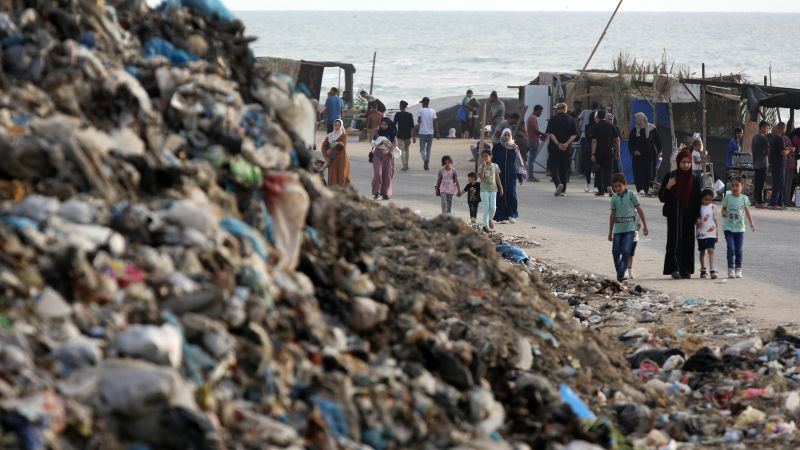CNN —
Untreated sewage, swarms of flies and mosquitoes, trash piling up in the streets: hundreds of thousands of people in Gaza face a sanitation crisis as the summer heat intensifies.
Ismail Zaida, a resident of northern Gaza City, told CNN his water supply had been cut off for nine months.
“The municipality is not functioning and tons of waste is piling up at our doorsteps and on the roads,” he said.
“We're seeing a lot of flying insects for the first time… frankly, there are insects we've never seen before, we don't even know the names of, and they're biting us and our children.”
Israel's relentless bombardment of Gaza, which began following the October 7 attacks, is now in its eighth month and has sparked a worsening humanitarian crisis.
Rights groups have repeatedly warned of “unspeakable” living conditions for Palestinians as Israeli military operations ravage neighborhoods, undermine medical infrastructure and deplete food, water and fuel supplies.
Abed Rahim Khatib/Anadolu/Getty Images
Palestinians queue to receive clean drinking water distributed by aid groups in Deir al-Bala.
There are few signs of a resolution to the protracted and bloody conflict. A U.S.-backed ceasefire plan was overwhelmingly approved by the United Nations Security Council this week, but neither side has accepted it. Israeli Prime Minister Benjamin Netanyahu has repeatedly said the ceasefire will remain in place until Hamas is defeated and the remaining hostages are released.
In Deir al-Bala, central Gaza, where thousands of displaced people are seeking refuge, families say shelters are overcrowded. They report a range of health problems, including hepatitis A, skin diseases and respiratory illnesses, and have very little access to water, the UN Office for the Coordination of Humanitarian Affairs (OCHA) said in an assessment this week.
According to OCHA, in one shelter the average amount of water available per day is less than one litre per person, well below the internationally recognised minimum of three litres per day needed for survival.
A safe water supply is essential not only for drinking and cooking, but also to prevent the spread of disease.
Mahmoud Issa/Reuters
A displaced Palestinian woman uses water to cook food in the Jabalia refugee camp in northern Gaza.
OCHA reported this week that more than two-thirds of water and sanitation facilities and infrastructure in Gaza have been destroyed or damaged by the fighting, adding that many other facilities are out of service due to issues including “insecurity, poor access, and a lack of electricity and fuel to run generators.”
OCHA said people's coping mechanisms are “severely stretched,” and the most vulnerable are lacking basic hygiene items such as soap, while collecting water from unreliable sources in inadequate containers.
Average maximum temperatures in the Gaza Strip over the next week are expected to be in the low 30s degrees Celsius, which could worsen an already critical sanitary situation.
Zaida, a resident of Gaza City, described how her unused swimming pool had started to attract insects.
“During the day, flies come and at night, mosquitoes infest the area…We light fires and burn rubbish at night until all the flying insects are gone.”
Zaida wears a mask for most of the day, in part because some vehicles run on frying oil instead of diesel, making it difficult to breathe.
“The streets are flooded with sewage, waste and bomb debris,” he said.
Sewage treatment, amid damaged infrastructure and fuel shortages, is a persistent problem in the Gaza Strip.
Karl Skau, deputy executive director of the World Food Programme, said after a visit to Gaza this week that one million people have been forced out of Rafah and are now “trapped” in “very congested areas along the coast in the scorching summer heat”.
“We drove through a river of sewage,” he said.
OCHA said the fuel supply had helped to reduce the level of accumulated sewage in Gaza City's Sheikh Radwan neighborhood, but “the lack of a stable fuel supply continues to pose a risk of sewage flooding into nearby areas.”
AFP/Getty Images
Rubbish piles up alongside a defunct sewage treatment plant in Gaza City on May 3.
“There are large amounts of sewage leaking from different parts of the city, even into the sea,” Gaza City Municipality spokesman Assem Al-Nabi told CNN.
“There is extensive damage to sewer pipes and sewer pumps, causing sewage and wastewater to leak throughout the city.”
He estimates that more than four kilometers of water pipes have been destroyed or damaged, something that would be extremely difficult to repair in the middle of a war.
According to an assessment by UN agencies and partners released last week, 67 percent of water and sanitation facilities and infrastructure in the Gaza Strip have been destroyed or damaged by the conflict.
There have been sporadic efforts to repair infrastructure. The Coastal Municipalities Water Authority, in partnership with the International Committee of the Red Cross, has repaired several wells in Khan Yunis, Deir al-Balah and Nuseirat.
But the scale of the mission, with no ceasefire and limited fuel supplies and equipment, far exceeds the capabilities of Gaza's local authorities.



